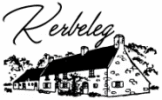This website uses cookies so that we can provide you with the best user experience possible. Cookie information is stored in your browser and performs functions such as recognising you when you return to our website and helping our team to understand which sections of the website you find most interesting and useful.
Saint Barbara: A Figure of Faith and Protection
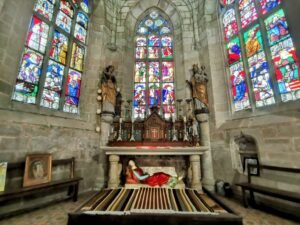
The history of Saint Barbara’s Chapel begins with the life of the saint of the same name. Saint Barbara, born in the 3rd century in Nicomedia, Asia Minor (today Izmir in Turkey), came from a pagan family. However, she embraced the Christian faith, which deeply displeased her father. He had her imprisoned in a tower and subjected to cruel torture to make her renounce her faith. Incredibly, Barbe survived these ordeals while maintaining her faith. Frustrated, her father beheaded her on 4 December 235, but a bolt of lightning struck him in the heart shortly afterwards. Since then, Saint Barbara has been associated with controlling fire and storms, becoming the patron saint of firefighters, miners, artificers, artillerymen and Royal sailors.
The birth of a chapel
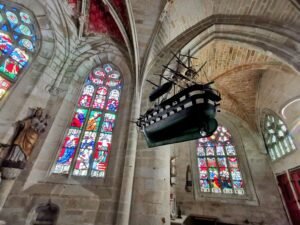
In 1489, a violent storm took the lord of Toulbodou by surprise while he was hunting in the area. Part of the rock face collapsed as a result of the lightning, causing an avalanche of stones near the hunter. Terrified, the lord implored Saint Barbara to save him from this perilous situation, promising to erect a chapel in his honour if he escaped death. The lord kept his promise, and work began the very next day. The flamboyant Gothic chapel, nestling between the rock face and a ravine, took 23 years to build.
Site Features: Stories and Legends
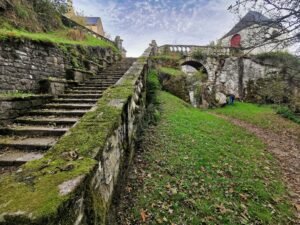
Other features of the site were added in the 18th century. The staircase to the chapel, dating from 1700, is an example of the architectural ingenuity of the period. During this period, an ossuary was also built into the main staircase, although its original purpose remains a mystery. During pardons, priests used it to sell medals and candles to the faithful.
Saint-Michel’s oratory, built into the rock, was once the place where men, high above the void, asserted their virility by circling the structure with rings, symbolising their victory over death. Its restoration, including carpentry, masonry, joinery and painting, was scheduled between 2018 and 2019 to preserve this historic element.
The treasures of the chapel
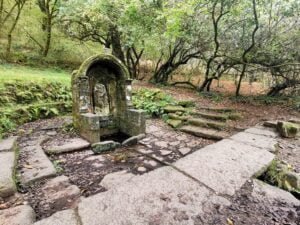
Before the French Revolution, the chapel’s bell tower housed two large bells and a smaller one. However, they were melted down to make weapons, giving way to the present bell in 1809, reputed to ward off lightning.
Descending the short flight of steps near the chapel and taking the path through the woods, visitors will discover the fountain 400 metres below. In days gone by, women would throw a hairpin into the fountain in the hope of getting married or having a baby in the coming year.
The Guardian and Nature
The caretaker’s house, dating from the 17th century, was once used as a hunting lodge, before becoming the residence of the chapel’s caretaker. Today, it provides visitors with souvenirs and a place to quench their thirst. The restoration of this historic house took around ten months, from September 2013 to the end of June 2014.
Finally, the stone forecourt near the caretaker’s house was completed between mid-March and the end of July 2015, adding a touch of elegance to this environment steeped in history.
Chapelle Sainte-Barbe is surrounded by unspoilt countryside, home to protected flora and fauna. It is forbidden to pick or gather natural elements in order to preserve the biodiversity of this place steeped in faith, promise and legend.

